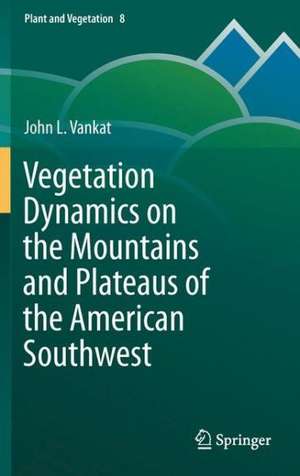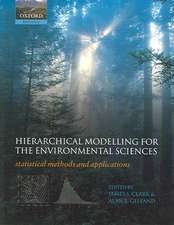Vegetation Dynamics on the Mountains and Plateaus of the American Southwest: Plant and Vegetation, cartea 8
Autor John Vankaten Limba Engleză Hardback – 11 iun 2013
| Toate formatele și edițiile | Preț | Express |
|---|---|---|
| Paperback (1) | 953.03 lei 43-57 zile | |
| SPRINGER NETHERLANDS – 23 iun 2015 | 953.03 lei 43-57 zile | |
| Hardback (1) | 966.78 lei 43-57 zile | |
| SPRINGER NETHERLANDS – 11 iun 2013 | 966.78 lei 43-57 zile |
Din seria Plant and Vegetation
- 18%
 Preț: 1125.86 lei
Preț: 1125.86 lei - 24%
 Preț: 802.91 lei
Preț: 802.91 lei - 18%
 Preț: 953.52 lei
Preț: 953.52 lei - 15%
 Preț: 642.83 lei
Preț: 642.83 lei - 18%
 Preț: 954.45 lei
Preț: 954.45 lei - 24%
 Preț: 1487.35 lei
Preț: 1487.35 lei - 24%
 Preț: 1329.20 lei
Preț: 1329.20 lei - 24%
 Preț: 962.66 lei
Preț: 962.66 lei - 18%
 Preț: 1405.09 lei
Preț: 1405.09 lei - 18%
 Preț: 1122.42 lei
Preț: 1122.42 lei - 24%
 Preț: 1049.67 lei
Preț: 1049.67 lei - 18%
 Preț: 1222.01 lei
Preț: 1222.01 lei - 18%
 Preț: 1219.16 lei
Preț: 1219.16 lei - 18%
 Preț: 1378.10 lei
Preț: 1378.10 lei - 18%
 Preț: 1230.35 lei
Preț: 1230.35 lei - 18%
 Preț: 1221.38 lei
Preț: 1221.38 lei - 18%
 Preț: 959.19 lei
Preț: 959.19 lei
Preț: 966.78 lei
Preț vechi: 1178.99 lei
-18% Nou
Puncte Express: 1450
Preț estimativ în valută:
184.99€ • 193.67$ • 153.07£
184.99€ • 193.67$ • 153.07£
Carte tipărită la comandă
Livrare economică 07-21 aprilie
Preluare comenzi: 021 569.72.76
Specificații
ISBN-13: 9789400761483
ISBN-10: 9400761481
Pagini: 476
Ilustrații: XIII, 461 p.
Dimensiuni: 155 x 235 x 31 mm
Greutate: 1.06 kg
Ediția:2013
Editura: SPRINGER NETHERLANDS
Colecția Springer
Seria Plant and Vegetation
Locul publicării:Dordrecht, Netherlands
ISBN-10: 9400761481
Pagini: 476
Ilustrații: XIII, 461 p.
Dimensiuni: 155 x 235 x 31 mm
Greutate: 1.06 kg
Ediția:2013
Editura: SPRINGER NETHERLANDS
Colecția Springer
Seria Plant and Vegetation
Locul publicării:Dordrecht, Netherlands
Public țintă
ResearchCuprins
1. Introduction.- PART I Forests.- 2. Spruce-Fir Forest.- 3. Mixed Conifer Forest.- 4. Ponderosa Pine Forest.- PART II Woodland, Savanna, Grassland, and Shrublands.- 5. Pinyon-Juniper.- 6. Subalpine-Montane Grassland.- 7. Gambel Oak Shrubland.- 8. Interior Chaparral Shrubland.- Index.
Notă biografică
John L. Vankat received an A.B. degree in biology from Carleton College, Northfield, Minnesota and M.A. and Ph. D. degrees in botany from the University of California, Davis. He taught and researched plant ecology in the Department of Botany, Miami University, Oxford, Ohio for thirty-one years. John’s interest in education led to his textbook The Natural Vegetation of North America: An Introduction. He completed forty-nine master’s and Ph.D. students, directing field research projects from California to Pennsylvania and from Alaska to Belize. John helped organize and was elected the first person to chair the Vegetation Section of the Ecological Society of America. Additionally, he helped organize and later chaired the North American Section of the International Association for Vegetation Science. After retiring from Miami University, John moved to Flagstaff, Arizona, where he accepted a four-year position as ecologist with Grand Canyon National Park to do research and bring research to bear on management issues. At present, John is Professor Emeritus from Miami University and both Senior Research Ecologist with the Merriam-Powell Center for Environmental Research and Adjunct Professor in the School of Forestry at Northern Arizona University in Flagstaff. He continues to research forests, woodlands, and shrublands in the American Southwest, focusing on vegetation dynamics, and continues his interest in using science to enhance management of natural areas. John has published in twenty peer-reviewed journals, including Ecology, Forest Ecology and Management, Journal of Vegetation Science, Journal of Biogeography, Conservation Biology, Ecological Modelling, and Landscape Ecology. He has presented invited lectures at thirty-seven universities in ten countries.
Textul de pe ultima copertă
This book provides information essential for anyone interested in the ecology of the American Southwest, including land and resource managers, environmental planners, conservationists, environmentalists, ecologists, land stewards, and students. The book is unique in its coverage of the hows and whys of dynamics (changes) in the major types of vegetation occurring on southwestern mountains and plateaus. The book explains the drivers and processes of change, describes historical changes, and provides conceptual models that diagrammatically illustrate past, present, and potential future changes.
All major types of vegetation are covered: spruce-fir forest, mixed conifer forest, ponderosa pine forest, pinyon-juniper vegetation, subalpine-montane grassland, Gambel oak shrubland, and interior chaparral shrubland. The focus is on vegetation that is relatively undisturbed, i.e., in natural and near-natural condition, and how it responds to natural disturbances such as fire and drought, as well as to anthropogenic disturbances such as fire exclusion and invasive species. Although intensive land uses such as logging are not included, knowledge of post-disturbance vegetation dynamics is applicable to the restoration and recovery of heavily disturbed areas.
The book has an introductory chapter followed by chapters on the major types of vegetation. Each vegetation chapter has an introduction that presents an overall description of the vegetation, followed by sections on (a) major drivers including climate, soil, natural disturbances such as fire, and anthropogenic disturbances such as livestock grazing, (b) key processes of vegetation dynamics such as succession, (c) vegetation conditions before Euro-American settlement, approaches used to determine them, and changes that followed, (d) a three-tiered suite of conceptual models of vegetation dynamics, and (e) conclusions and key challenges for researchers and managers.
All major types of vegetation are covered: spruce-fir forest, mixed conifer forest, ponderosa pine forest, pinyon-juniper vegetation, subalpine-montane grassland, Gambel oak shrubland, and interior chaparral shrubland. The focus is on vegetation that is relatively undisturbed, i.e., in natural and near-natural condition, and how it responds to natural disturbances such as fire and drought, as well as to anthropogenic disturbances such as fire exclusion and invasive species. Although intensive land uses such as logging are not included, knowledge of post-disturbance vegetation dynamics is applicable to the restoration and recovery of heavily disturbed areas.
The book has an introductory chapter followed by chapters on the major types of vegetation. Each vegetation chapter has an introduction that presents an overall description of the vegetation, followed by sections on (a) major drivers including climate, soil, natural disturbances such as fire, and anthropogenic disturbances such as livestock grazing, (b) key processes of vegetation dynamics such as succession, (c) vegetation conditions before Euro-American settlement, approaches used to determine them, and changes that followed, (d) a three-tiered suite of conceptual models of vegetation dynamics, and (e) conclusions and key challenges for researchers and managers.
Caracteristici
The only book focusing on vegetation dynamics (i.e., changes) on uplands of the American Southwest Essential information for anyone interested in the vegetation of the American Southwest, including land managers, resource managers, environmental planners, conservationists, ecologists, and students Broad coverage that includes forests, grassland, and shrublands Consistent organization of chapters facilitates direct comparison of different types of vegetation A three-tiered set of conceptual models of the vegetation dynamics of each of seven major types of vegetation Many colour images, including numerous, strikingly illustrative photographs Reproduces some of the oldest historical photographs of upland vegetation taken in the American Southwest
















